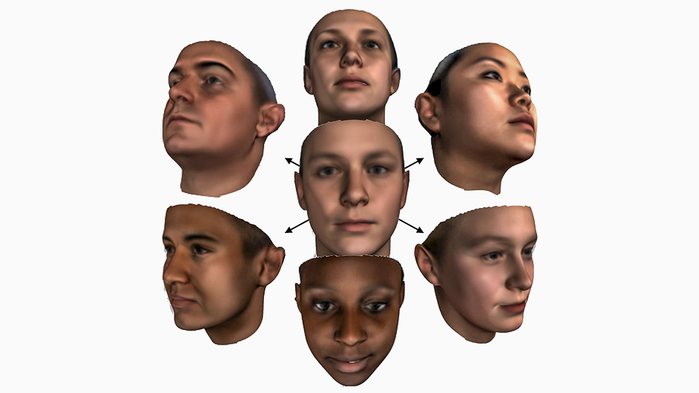Scientists have created the most advanced digital model of a human face.

When computers process faces, they sometimes rely on 3D Morphable Model (3DMM). The model is an average person and contains information about the general patterns of deviation from this average. For example, if you have a long nose, you may also have a wide chin. Considering such correlations, the computer can then characterize your unique face without saving each point in the 3D scan, but by listing only a couple of hundred numbers describing your deviation from the average face, including parameters that roughly correspond to the age, sex, and length of the face.
However, there is one difficulty. To take into account all the ways in which a person may change, 3DMM has to integrate information about a large number of people. Until now, this required the scanning of a large number of people, and after - painstaking labeling of all their functions. Consequently, the best modern models are based on the faces of only a few hundred people — mostly white adults — and have a limited ability to model the faces of people of different ages and races.
')
Computer researcher from Imperial College London, James Booth (James Booth) and his colleagues have developed a new method that automates the creation of 3DMM and allows them to use a wider range of human faces. The method consists of three basic steps. First, the algorithm automatically orients the face scan to the tip of the nose and other points. Then another algorithm aligns all scans in accordance with the landmarks and combines them into a model. Further, the algorithm searches for and removes bad scans.
Other researchers favorably embraced the idea of James Booth. William Smith, who studies computer vision at the University of York in the UK, who did not participate in the study, noted that automating the process of creating models is indeed a great contribution in this area. Another scientist from the Institute of Computer Graphics Research. Fraunhofer in Darmstadt Alan Brunton (Alan Brunton) said: “Marking dozens of features on a large number of persons is quite tiresome. You think that pressing a point is relatively easy, but it’s not always obvious where, for example, the corner of the mouth is. Therefore, even when you do it manually, there is a high probability of making a mistake. ”
Booth and his colleagues did not stop there. They applied their method to the recruitment of almost 10,000 demographically diverse face scans. The scan was done at a science museum in London by plastic surgeons Allan Ponniah and David Dunaway, who are hoping to improve recovery operations. They turned to Stefanos Zafeiriou, a computer researcher at Imperial College London, for help with data analysis.
The application of the algorithm to these scans led to the creation of what they call the “large scale facial model - LSFM). As the authors report, in tests against existing LSFM models it portrays faces much more accurately. In one comparison, they created a model of a child’s face from a photograph. When using LSFM, the model really looked like a child. Using one of the most popular models, which is entirely based on the faces of adults, the child’s face predictably looked like an adult’s face.
The team of scientists had a sufficient number of sweeps to create more specific modifiable models for different races and ages. Their model can automatically classify individuals in age groups according to form.
Booth and other researchers have already worked on a new model. In another experiment, they used 100,000 individuals synthesized by their LSFM to train an artificial intelligence program to turn 2D images into accurate 3D models. This method can be used to verify the identity of a person suspected of committing a crime from a camera image, even if it was made at an angle. In addition, with the help of this algorithm it is possible to embody and revive historical figures recreated from portraits.
Soon medical applications may appear on the basis of LSFM. If someone has lost his nose, technologists can help plastic surgeons determine how the new face should look, considering the rest of the face. Face scans can be used to determine possible genetic diseases, such as Williams syndrome, conditions associated with heart problems, developmental delays and features of the face, such as a short nose and wide mouth. Model Bout and his colleagues can increase the sensitivity of such tests. The next step is to include facial expressions in models that allow you to recognize faces with grimaces or smiles.
Source: https://habr.com/ru/post/373423/
All Articles